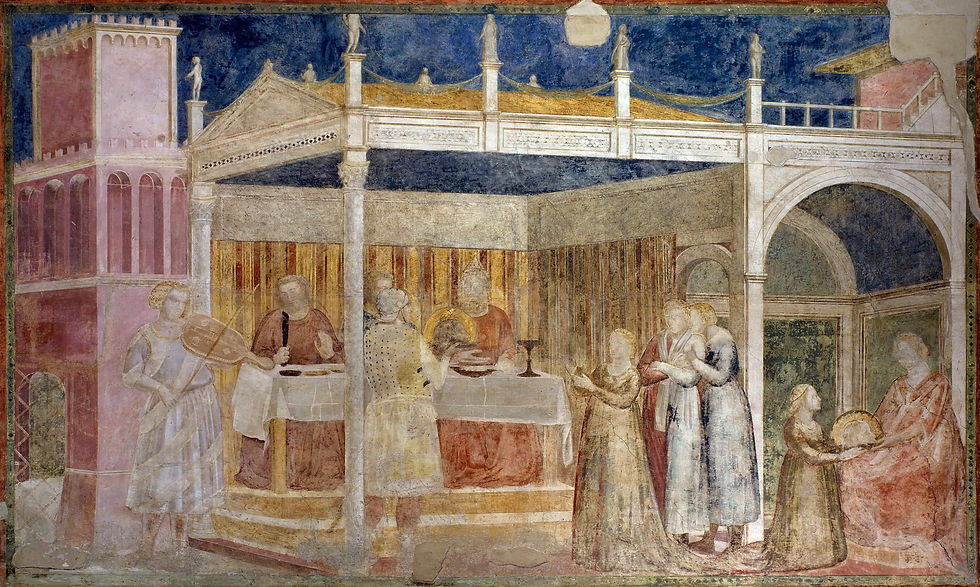Wine, vine and winegrowers are used in many allegories and parables

PARABLE OF THE WORKERS IN THE VINEYARD
Salomon Koninck (1609-1656)
1647-1649
The Hermitage, St Petersburg, Russia
It is the harvest season. A vineyard owner can see that it is time to pick the grapes. Around 6 o’clock in the morning, he leaves his house and goes to the market in search of some day-laborers. He hires several workers at the rate of one denier for the day. At the time, agricultural workers would labour from dawn until dusk, from around 6 am to 6 pm. Three hours later, at 9am, the vineyard owner returns to the market to take on more workers. He promises them a reasonable wage, but without specifying a precise amount. As the work continues, the vineyard owner sees that he is going to need even more help.
The vineyard owner returns to the market at the sixth hour (noon) and the ninth hour (3pm) to hire yet more workers. This time, he does not tell them how much they will be paid. Towards the end of the afternoon, it becomes clear that the harvest won’t be finished in time. The vineyard owner goes back to the market for the fifth time at the ‘eleventh hour’ (5pm), only one hour before the end of the working day. There he hires some more labourers, who have been waiting for work all day, and sends them to join the others. At nightfall, the employer calls together all the workers and pays them all one denier, regardless of the number of hours each man has worked. The workers hired at 6am react badly to the unfairness of this. The vineyard owner simply reminds them that they have been paid the amount agreed and that he can spend his money as he likes.
Parables are used in the Bible to convey Christ’s teachings on a number of subjects. The stories are taken from everyday life to explain the ‘kingdom of God’: God’s expectations of mankind, what mankind can expect of God, and how to respect God and other people.

THE PARABLE OF THE VINEYARD Domenico Fetti's workshop, ca. 1618 - Galleria Palatina, Florence, Italy

THE PARABLE OF THE VINEYARD Domenico Fetti's workshop, ca. 1618 - Galleria Palatina, Florence, Italy THE PARABLE OF THE WORKERS IN VINEYARD (LA PARABOLE DES OUVRIERS DE LA ONZIÈME HEURE), J. Lambert, ca. 1615-36 - MFA, Rouen, France
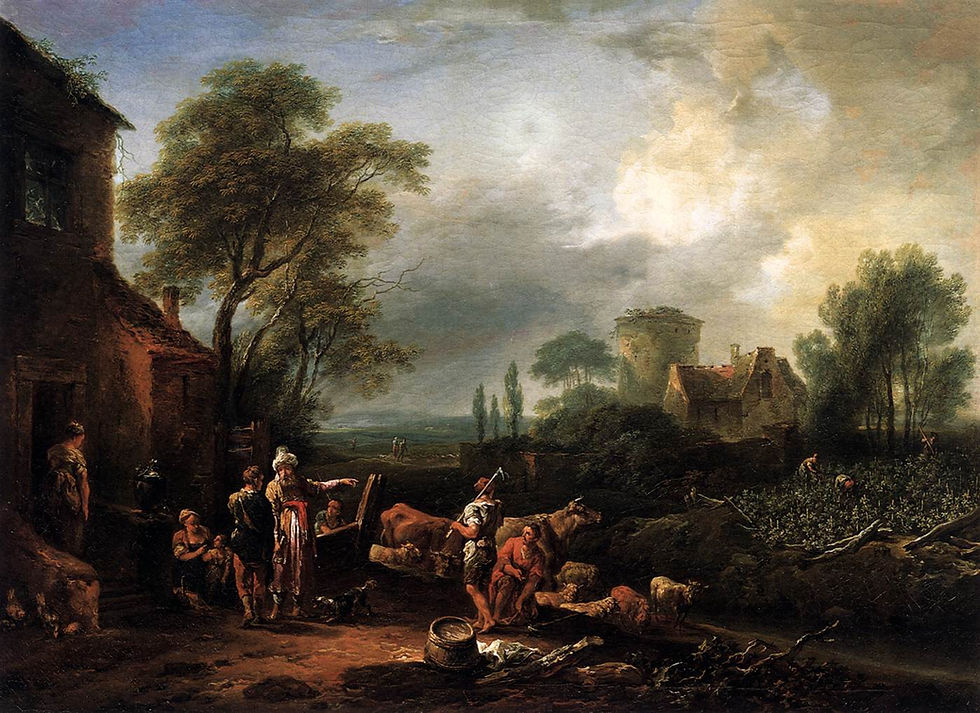
PARABLE OF THE WORKERS IN THE VINEYARD J-C. Brand, 1769 - Akademie der bildenden Künste, Vienna, Austria
> Click on the icons for a closer look at the artworks
Bible Verses: New Testament, Matthew 20:1-16
« For the kingdom of heaven is like unto a man that is an householder, which went out early in the morning to hire labourers into his vineyard. And when he had agreed with the labourers for a penny a day, he sent them into his vineyard. And he went out about the third hour, and saw others standing idle in the marketplace, And said unto them; Go ye also into the vineyard, and whatsoever is right I will give you. And they went their way. Again he went out about the sixth and ninth hour, and did likewise. And about the eleventh hour he went out, and found others standing idle, and saith unto them, Why stand ye here all the day idle? They say unto him, Because no man hath hired us. He saith unto them, Go ye also into the vineyard; and whatsoever is right, thatshall ye receive. So when even was come, the lord of the vineyard saith unto his steward, Call the labourers, and give them their hire, beginning from the last unto the first. And when they came that were hired about the eleventh hour, they received every man a penny. But when the first came, they supposed that they should have received more; and they likewise received every man a penny. And when they had received it, they murmured against the goodman of the house, Saying, These last have wrought but one hour, and thou hast made them equal unto us, which have borne the burden and heat of the day. But he answered one of them, and said, Friend, I do thee no wrong: didst not thou agree with me for a penny? Take that thine is, and go thy way: I will give unto this last, even as unto thee. Is it not lawful for me to do what I will with mine own? Is thine eye evil, because I am good? So the last shall be first, and the first last: for many be called, but few chosen. »nt les premiers, et les premiers seront les derniers. »
THE WICKED HUSBANDMEN, THE VINEYARD OF THE LORD, CHRIST THE TRUE VINE
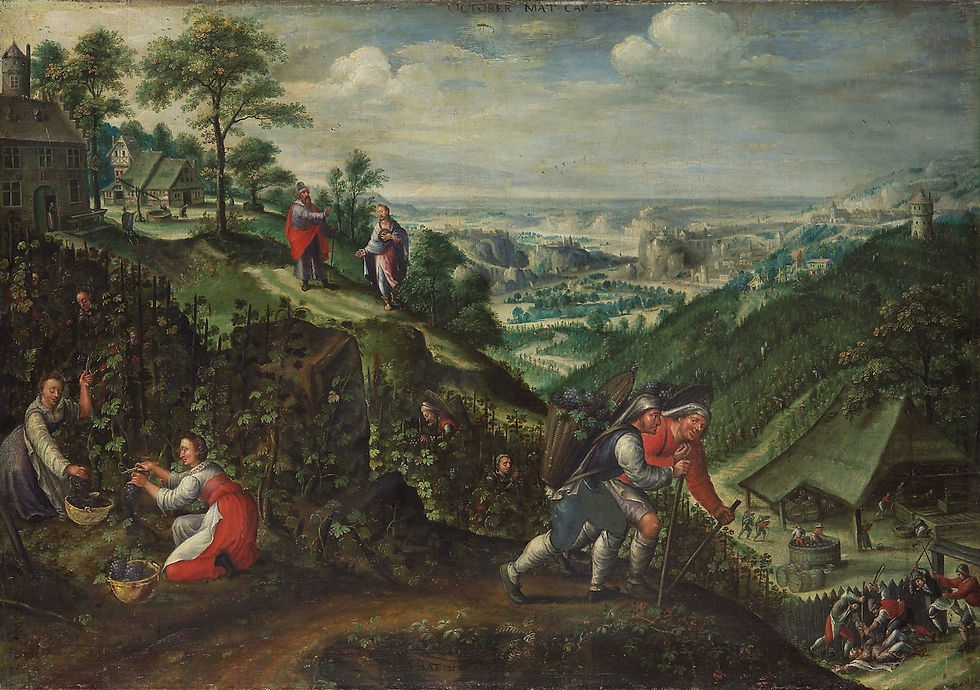
THE WICKED HUSBANDMEN (OCTOBER) Marten van Valckenborch Between 1580 and 1590 - Kunsthistorisches Museum,Vienna, Austria / 1

THE VINEYARD OF THE LORD Lucas Cranach the Younger, 1569 - St. Mary's Church, Wittenberg, Germany / 2

CHRIST THE TRUE VINE After Angelos Akotantos (Crete) Early 15th century - Dormition Convent, Parnes, Greece / 3 Unknown Master / 2
> Click on the icons for a closer look at the artworks
1. In his homily LXVIII on Matthew, Jean Chrysostome describes the servants as prophets and the vineyard owner’s son as Christ himself. God asks mankind to ‘bear fruit’ in the same way as the vine. This parable is not dissimilar to that of The True Vine (see below).
Bible Verses: New Testament, Matthew 21:33-39
"Hear another parable: There was a certain householder, which planted a vineyard, and hedged it round about, and digged a winepress in it, and built a tower, and let it out to husbandmen, and went into a far country: And when the time of the fruit drew near, he sent his servants to the husbandmen, that they might receive the fruits of it. And the husbandmen took his servants, and beat one, and killed another, and stoned another. Again, he sent other servants more than the first: and they did unto them likewise. But last of all he sent unto them his son, saying, They will reverence my son. But when the husbandmen saw the son, they said among themselves, This is the heir; come, let us kill him, and let us seize on his inheritance. And they caught him, and cast him out of the vineyard, and slew him.
2. Lucas Cranach the Younger dedicated this painting to Paul Eber, a famous Lutherian theologian who had recently died (Jean-Sebastian Bach used Eber’s texts as a basis for many of his cantatas and choral pieces). Drawing inspiration from the Book of Matthew, Lucas Cranach the Younger creates a Protestant allegory, with the Protestant reformists representing the good tenants (right) and the Catholic Church representing the wicked (left). Luther, a good friend of the artist’s father Lucas Cranach the Elder, also figures in the composition. Here, the artist contrasts the outrageous excesses of the Catholic Church with the rigor of Protestantism.
3. Iconography showing Christ as the ‘True Vine’ first emerged in 15th-century Crete and on Mount Athos in Macedonia, where numerous artists found refuge after the fall of Constantinople in 1453. Such imagery spread over the course of the 16th and 17th century, eventually becoming a feature of liturgical decoration for priests and bishops. The icon reproduced here shows Christ at the centre of a vine with a holy book open on his knees, raising his hands in blessing. Twelve shoots are growing from the foot of the vine, and among their leaves and grapes we can see the twelve apostles. Peter and Paul are to the right and left of Jesus respectively. Each apostle is identifiable, and shown holding a book or a reliquary.
This theme is typically eucharistic. During the Last Supper, after washing his disciples’ feet, Jesus compared himself to a vine, God to the vineyard owner and his disciples to the branches.
Bible Verses: New Testament, John 15:1-8
"I am the true vine, and my Father is the husbandman. Every branch in me that beareth not fruit he taketh away: and every branch that beareth fruit, he purgeth it, that it may bring forth more fruit. Now ye are clean through the word which I have spoken unto you. Abide in me, and I in you. As the branch cannot bear fruit of itself, except it abide in the vine; no more can ye, except ye abide in me. I am the vine, ye are the branches: He that abideth in me, and I in him, the same bringeth forth much fruit: for without me ye can do nothing. If a man abide not in me, he is cast forth as a branch, and is withered; and men gather them, and cast them into the fire, and they are burned. If ye abide in me, and my words abide in you, ye shall ask what ye will, and it shall be done unto you. Herein is my Father glorified, that ye bear much fruit; so shall ye be my disciples."
THE WISE AND FOOLISH VIRGINS

PARABLE OF THE WISE AND FOOLISH VIRGINS Francken Hieronymus II, ca. 1616 - The Hermitage, St Petersburg, Russia / 1
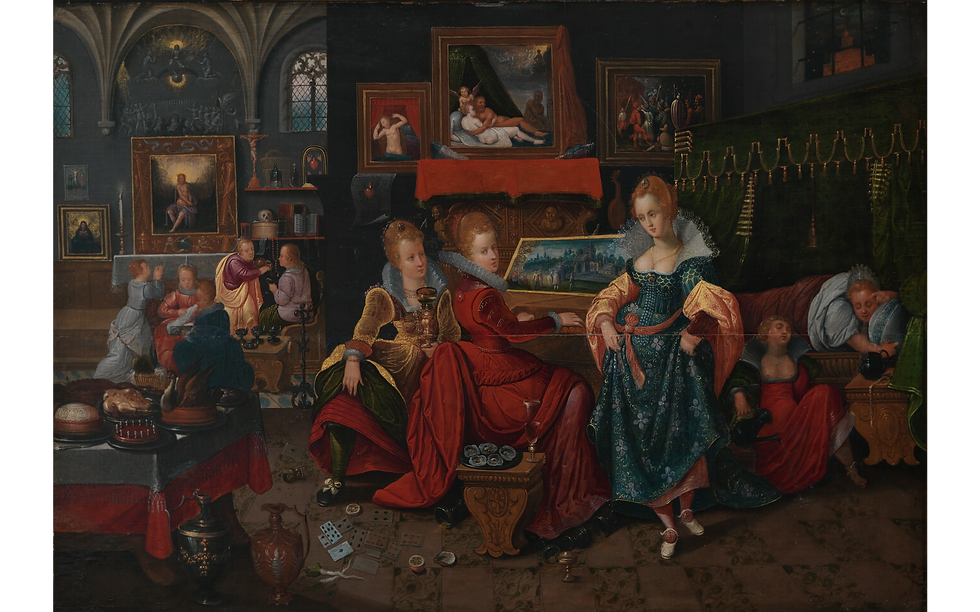
THE PARABLE OF THE WISE AND THE FOOLISH VIRGINS Hieronymus Francken II, 1593/1623 - SMC, Copenhagen, Denmark

THE FOOLISH VIRGINS AND THE WISE VIRGINS Pieter Lisaert III, 1590s - Museo del Prado, Madrid, Spain
> Click on the icons for a closer look at the artworks
1. The parable sets a moral standard and the abuse of wine exemplifies bad behavior. To the left, some of the virgins drink, gamble, play music, act and laze around – all behaviors denounced by the Church. To the right, the others devote themselves to prayer, religious education and domestic tasks. The Parable of the Wise and Foolish Virgins is also called the Parable of the Ten Virgins. For some, ten is a symbolic number which denotes plenitude; the virgins of the parable represent Christ’s followers.
Bible Verses: New Testament, Matthew 25:1-13
"Then shall the kingdom of heaven be likened unto ten virgins, which took their lamps, and went forth to meet the bridegroom. And five of them were wise, and five were foolish. They that were foolish took their lamps, and took no oil with them: But the wise took oil in their vessels with their lamps. While the bridegroom tarried, they all slumbered and slept. And at midnight there was a cry made, Behold, the bridegroom cometh; go ye out to meet him. Then all those virgins arose, and trimmed their lamps. And the foolish said unto the wise, Give us of your oil; for our lamps are gone out. But the wise answered, saying, Not so; lest there be not enough for us and you: but go ye rather to them that sell, and buy for yourselves. And while they went to buy, the bridegroom came; and they that were ready went in with him to the marriage: and the door was shut. Afterward came also the other virgins, saying, Lord, Lord, open to us. But he answered and said, Verily I say unto you, I know you not. Watch therefore, for ye know neither the day nor the hour wherein the Son of man cometh."
Suggestion: Johann Sebastian Bach, Cantata BWV 140 Wachet auf, ruft uns die Stimme... Wo seid ihr klugen Jungfrauen? / Wake up, the voice calls uscall to you... Where are you, wise virgins? (1731)
THE RICH MAN AND LAZARUS, THE GOOD SAMARITAN, THE NEW WINE INTO OLD WINESKINS

KITCHEN SCENE WITH THE PARABLE OF THE RICH MAN AND POOR LAZARUS Pieter C. van Rijck (attr.), 1610/20 - Rijksmuseum, Amsterdam, Netherlands
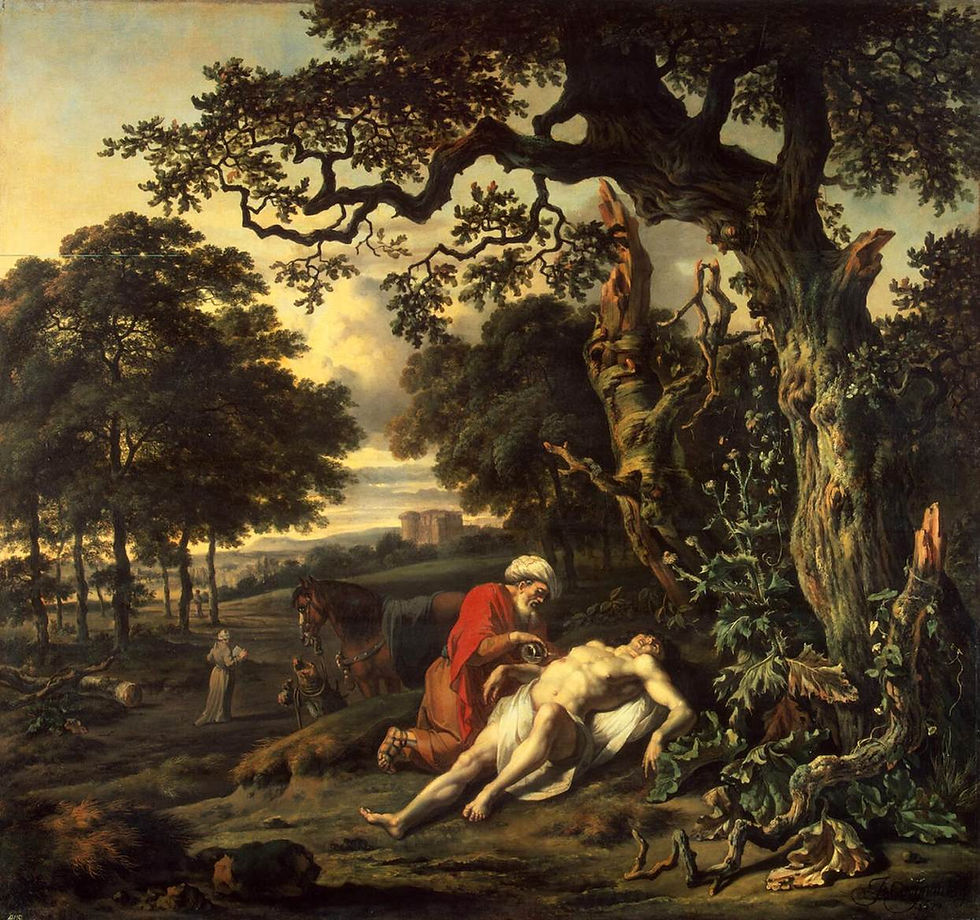
THE GOOD SAMARITAN TENDS THE WOUNDS OF THE TRAVELLER Balthasar van Cortbemde, 1647 - Royal FA Museum, Antwerp, Belgium / 2

PORTER WITH A WINESKIN, Niko Pirosmani bef. 1919 - The State Museum of Fine Arts of Georgia, Tbilisi, Georgia
> Click on the icons for a closer look at the artworks
1. La parabole de l'homme riche et de Lazare oppose deux personnages : l’un est riche, l’autre pauvre ; l’un est vêtu de pourpre, l’autre couvert d’ulcères. La pourpre et le lin ne soulignent pas seulement le luxe, mais aussi l’appartenance à un rang social élevé. Le riche fait des festins de manière quotidienne tandis que le pauvre n’a rien pour se nourrir et qu'un chien pour compagnie.
Bible verses: New Testament, Luke 16: 19-31
"There was a certain rich man, which was clothed in purple and fine linen, and fared sumptuously every day: And there was a certain beggar named Lazarus, which was laid at his gate, full of sores, And desiring to be fed with the crumbs which fell from the rich man's table: moreover the dogs came and licked his sores. And it came to pass, that the beggar died, and was carried by the angels into Abraham's bosom: the rich man also died, and was buried; And in hell he lift up his eyes, being in torments, and seeth Abraham afar off, and Lazarus in his bosom. And he cried and said, Father Abraham, have mercy on me, and send Lazarus, that he may dip the tip of his finger in water, and cool my tongue; for I am tormented in this flame. But Abraham said, Son, remember that thou in thy lifetime receivedst thy good things, and likewise Lazarus evil things: but now he is comforted, and thou art tormented. And beside all this, between us and you there is a great gulf fixed: so that they which would pass from hence to you cannot; neither can they pass to us, that would come from thence. Then he said, I pray thee therefore, father, that thou wouldest send him to my father's house: For I have five brethren; that he may testify unto them, lest they also come into this place of torment. Abraham saith unto him, They have Moses and the prophets; let them hear them. And he said, Nay, father Abraham: but if one went unto them from the dead, they will repent. And he said unto him, If they hear not Moses and the prophets, neither will they be persuaded, though one rose from the dead."
2. This parable centres around a traveller who is attacked and left for dead by bandits. A cohen (priest) and a Levite – both Jews embodying the religious orthodoxy of the time – pass him by without stopping, prioritising their duties in the temple. Touching blood – and especially a dead body – would “disqualify” them from serving there. Samaritans were not subject to this law, as they were thought impious; here, the “good Samaritan” shows compassion for the injured stranger. He goes to him and tends his wounds, using oil and wine to clean them. Wine is associated with the blood of Christ, symbolised in the Last Supper.
Bible Verses: New Testament, Luke 10: 25-37
"And, behold, a certain lawyer stood up, and tempted him, saying, Master, what shall I do to inherit eternal life? He said unto him, What is written in the law? how readest thou? And he answering said, Thou shalt love the Lord thy God with all thy heart, and with all thy soul, and with all thy strength, and with all thy mind; and thy neighbour as thyself. And he said unto him, Thou hast answered right: this do, and thou shalt live. But he, willing to justify himself, said unto Jesus, And who is my neighbour? And Jesus answering said, A certain man went down from Jerusalem to Jericho, and fell among thieves, which stripped him of his raiment, and wounded him, and departed, leaving him half dead. And by chance there came down a certain priest that way: and when he saw him, he passed by on the other side. And likewise a Levite, when he was at the place, came and looked on him, and passed by on the other side. But a certain Samaritan, as he journeyed, came where he was: and when he saw him, he had compassion on him, And went to him, and bound up his wounds, pouring in oil and wine, and set him on his own beast, and brought him to an inn, and took care of him. And on the morrow when he departed, he took out two pence, and gave them to the host, and said unto him, Take care of him; and whatsoever thou spendest more, when I come again, I will repay thee. Which now of these three, thinkest thou, was neighbour unto him that fell among the thieves? And he said, He that shewed mercy on him. Then said Jesus unto him, Go, and do thou likewise."
3. This parable refers to the ‘new wine’ of Christian teachings which is incompatable with the ‘old wineskins’ of the scribes and Pharisees. This parable was aimed at Jews who refused to be evangelised and also encouraged the young Christian community to remain faithful and reject heretical teachings. It proved difficult to reconcile new religious practices with long-standing Jewish tradition.
Bible Verses: New Testament, Matthew 9: 16-17
"No man putteth a piece of new cloth unto an old garment, for that which is put in to fill it up taketh from the garment, and the rent is made worse. Neither do men put new wine into old bottles: else the bottles break, and the wine runneth out, and the bottles perish: but they put new wine into new bottles, and both are preserved."
GALLERIES THE BLOOD OF CHRIST IN THE NEW TESTAMENT AND CHRISTIAN ICONOGRAPHY
> Wine and Painting > From Divine to Sacred > SThe Blood of Christ in the New Testament and Christian Iconography > Allegories and Parables



